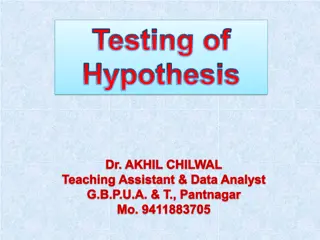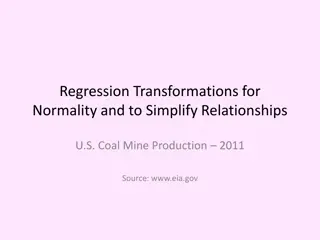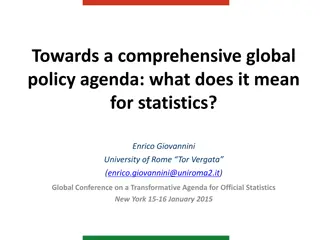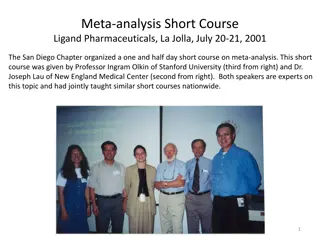Understanding Box-Cox Transformation in Statistical Analysis
Box-Cox transformation is a powerful tool in statistical analysis, allowing for better model fitting by transforming response variables to a power that optimizes the data distribution. Common values of lambda are discussed for different types of data. The validity of statements of statistical significance when using transformed data is also highlighted, emphasizing the importance of retaining raw data in result reporting. ANOVA and mean comparison techniques are explored, along with the rationale behind preserving ordered differences between treatment groups.
- Statistical Analysis
- Box-Cox Transformation
- Lambda Values
- Data Transformation
- Statistical Significance
Download Presentation

Please find below an Image/Link to download the presentation.
The content on the website is provided AS IS for your information and personal use only. It may not be sold, licensed, or shared on other websites without obtaining consent from the author. Download presentation by click this link. If you encounter any issues during the download, it is possible that the publisher has removed the file from their server.
E N D
Presentation Transcript
The Box-Cox Transformation Sometimes a transformation on the response fits the model better than the original response. A commonly used transformation raises the response to some power. Box and Cox (1964) formalized and described this family of power transformations. (From JMP Help menu). 2
The functional form The transformed response variables are then: 1 Y ( ) = Y 1 Y when lambda is not zero and is ln(Y) if zero, and where is the geometric mean. Y 3
What are common values of lambda? For Poisson data lambda=0, i.e. ln(Y) For most growth data lambda=1/2 If variance decreases with the mean then lambda=-1. For some percentage data, arcsin square root is the appropriate transformation. 4
Validity of statements of Statistical significance The validity of statements of significance depend on the validity (at least approximate validity) of the distributional assumptions. If the raw data does not satisfy the assumptions, but the transformed data does, then report the significance for the transformed data. This includes F-tests and tests of mean comparisons. However, use the raw data in the report of the results. 5
Report the untransformed mean values in the Results Level 4 5723.0000 3 2941.7500 1 159.7500 5 10.7500 C 2 6.2500 C Mean A A B 9
Why is this reasonable? The Box-Cox transformations are monotone, continuous functions. Any ordered differences between means of Trt groups is therefore preserved. Conclusions about Trt group mean differences are also therefore valid. 10























